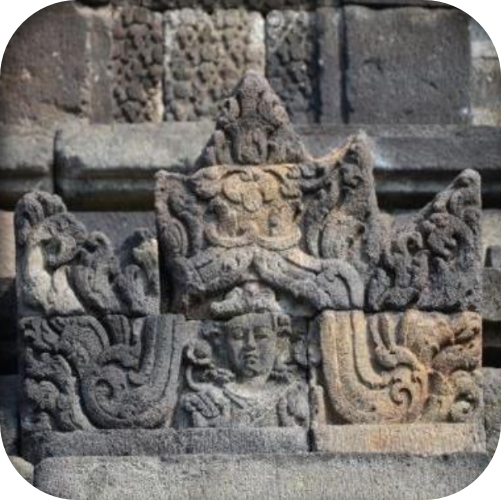Decorative Motifs and Periodization of Badut Temple: Comparative Review of Art Forms with The Temples of Central JavanesePeriod Ragam Hias dan Periodisasi Candi Badut: Tinjauan Perbandingan Bentuk Seni dengan Candi-Candi Periode Jawa Tengah
Main Article Content
Abstract
There are two known arguments of the periodization of Candi Badut. Firstly, grouping this temple as part of the oldest temple in Java, covering the early to mid-8th century AD. Secondly, positioning this temple in the period of later half of the 9th to early 10th centuries AD. The argument that Candi Badut belongs to the oldest temples in Java’s group is more widely accepted. Thus, this article discusses art analysis of Candi Badut as periodization aspect. The analysis conducted towards decorative or ornamental motifs through the comparative method with the temples in the Central Java period. The research result shows that Candi Badut has several distinguished decorative motifs, such as the kinnara-kinnari motif, the antefix motif, and the decoration above of the Kala motif. Those motifs are considered evidence that Candi Badut belongs to the later half of the 9th century to the early 10th century AD.
Article Details

This work is licensed under a Creative Commons Attribution-NonCommercial-ShareAlike 4.0 International License.
References
Bosch, F. D. K. (1916). De Sanskrit-inscriptie op den steen van Dinaja (682 Çaka). Albrecht. https://books.google.co.id/books?id=8BBeNQAACAAJ
Bosch, F. D. K. (1924). Het Lingga-Heiligdom van Dinaja / Frederik David Kan Bosch ; met naschrift van B. Schrieke (B. J. O. (Bertram J. O. Schrieke 1890-1945, Ed.). Albrecht.
Chihara, D. (1996). Hindu-Buddhist Architecture in Southeast Asia. Brill.
De Haan, B. (1924). Oudheidkundig Verslag 1923.
Degroot, V. (2009). Candi Space and Lansdscape: A Study on Distribution, Orientation, and Spatial Organization of Central Javanese Temple Remains. . Mededeligen van het Rijksmuseum voor Volkenkunde.
Dumarcay, J. (1986). The Temples of Java. Oxford University Press.
Dumarcay, J. (1988). Architectural Composition in Java From The Eighth to Fourteenth Centuries. Oxford University Press.
Dumarcay, J. (2005). Contruction Techniques in South and Southeast Asia. Brill (handbook of Oriental Studies III).
Jordaan, R. E. (1993). Imagine Buddha in Prambanan: reconsidering the Budhist background of the Loro Jonggrang temple complex. In Semaian. Rijksuniversiteit Leiden.
Jordaan, R. E. (2011). Candi Badut and the trajectory of Hindu-Javanese temple architecture. Artibus Asiae , 71(1), 55–74.
Jordaan, R. E., & Colless, B. E. (2009). The Mahārājas of the isles: the Śailendras and the problem of Śrivijaya (Issue 25). Department of Languages and Cultures of Southeast Asia and Oceania, University of Leiden.
Klokke, M. J. (2000). Ornamental motifs: the stylistic method applied to ancient Javanese temple art. In R. S. Lobo W. (Ed.), Southeast Asian Archeology 1998 (pp. 85–98). Hull: Centre for Southeast Asian Studies, University of Hull.
Klokke, M. J. (2006). The history of Central Javanese architecture: architecture and sculptural decoration as complementary sources of information. In Chambert-Loir H - Dagens B. (Ed.), Anamorphoses: hommage à Jacques Dumarçay (pp. 49–68).
Klokke, M. J. (2007). An Indonesian Sculpture In The Kröller-Müller Museum.”. Aziatische Kunst, 37(4), 3–14.
Klokke, M. J. (2008). The Buddhist temples of the Śailendra dynasty in Central Java. Arts Asiatiques, 63, 154–167. http://www.jstor.org/stable/43486580
Krom, N. J. (1923). Inleiding tot de Hindoe-Javaansche Kunst (1st edition, Vol. 3). Martinus Nijhoff.
Krom, N. J. (1931). Hindoe-Javaansche Geschiedenis. The Hague: Nijhoff.
Miksic, J. N. (1994). Imagine Buddha in Prambanan: Reconsidering the Buddhist Background of the Loro Jonggrang Temple Complex. By Roy E. Jordaan. Leiden: Vakgroep Talen en Culturen van Zuidoost-Azie en Oceanie, Rijksuniversiteit te Leiden, 1993. Pp. 65. Maps, Figures, Appendices, Bibliography, Index. Journal of Southeast Asian Studies, 25(2), 442–444. https://doi.org/10.1017/S0022463400013692
Poerbatjaraka. (1952). Riwajat Indonesia 1. Yayasan Pembangunan.
Poerbatjaraka. (1992). Agastya di nusantara. Yayasan Obor.
Pradnyawan, D. (2019). Kisah Tiga Candi di Jawa. In D. A. Tanudirjo (Ed.), Kuasa Makna (pp. 115–150). Departemen Arkeologi FIB UGM.
Pradnyawan, D. (2023). Arsitektur dan Seni Candi Kedulan. PURBAWIDYA: Jurnal Penelitian Dan Pengembangan Arkeologi, 12(1), 1–16. https://doi.org/10.55981/purbawidya.2023.93
Soekmono, R. (1979). The Archaeology of Central Java before 800 A.D. In R. B.-W. W. Smith (Ed.), Early South East Asia. Essays in Achaeology, History and Historical Geography. Oxford University Press.
Soekmono, R. (1990). Indonesian architecture of the Classical Period: a brief survey. The Sculpture of Indonesia, 67–95.
Soenarto, Th. A. (1996). Candi Badut dan Pemugarannya. Bagian Proyek Pembinaan Peninggalan Sejarah dan Purbakala Jawa Timur.
Stutterheim, W. F. (1941). Oudheidkundig Verslag 1940.
van der Meulen, W. J. (1976). THE PURĪ PŪTIKEŚVARAPĀVITA AND THE PURA KĀÑJURUHAN. Bijdragen Tot de Taal-, Land- En Volkenkunde, 132(4), 445–462. http://www.jstor.org/stable/27863082
van der Meulen, W. J. (1979). King Sanjaya and His Successors. Indonesia, 28, 17–54. https://doi.org/10.2307/3350894
Vogler, E. B. (1949). De monsterkop uit het omlijstingsornament van tempeldoor gangen en –nissen in de Hindoe-Javaanse bouwkunst. Brill.
Vogler, E. B. (1952). De stichtingstijd van de Tjandi’s Gunung Wukir en Badut (met platen). Bijdragen Tot de Taal-, Land- En Volkenkunde / Journal of the Humanities and Social Sciences of Southeast Asia, 108(4), 313–346. https://doi.org/10.1163/22134379-90002422
Williams, J. (1981). The Date of Barabudur in Relation to Other Central Javanese Monuments. In L. O.-W. H. W. Gomez (Ed.), Barabudur. History and Significance of a Buddhist Monument (pp. 25–46). University of California.

